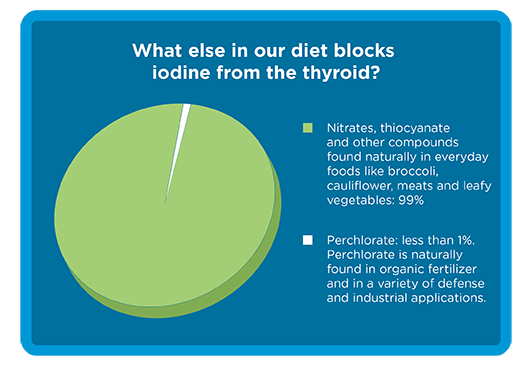It is an accepted fact in the medical community that any effect perchlorate may have on the human body is limited to the thyroid gland. No studies show that environmental levels of perchlorate cause harm to human health.
There are no measurable human health effects from low levels of perchlorate.
There are no measurable health effects when perchlorate is consumed at levels below 245 ppb. Any effects of high levels of perchlorate exposure are fully reversible once exposure declines or stops because perchlorate is not stored in the body. The 2005 National Academy of Sciences report found that adverse effects of perchlorate exposure are only theoretical and have not been demonstrated in humans, and exposure to perchlorate over months and years must exceed levels above 14,000 ppb before there can be a risk of adverse effects.
To put this in perspective, more than 98% of perchlorate detections in U.S. water systems are below 10 ppb – that’s 24 times lower than the recognized no effect level. At 10 ppb, a human would have to drink almost 740 gallons of water a day before a health risk could be possible.
Cancer Facts
The issue of whether perchlorate poses a cancer risk is a critical one, and one on which the science has been clear; perchlorate does not cause cancer.
After careful review, the National Academy of Sciences panel on perchlorate concluded that perchlorate is unlikely to cause cancer. Earlier studies of rats that had led to speculation about cancer in humans were dismissed by the NAS, which stated it is unlikely perchlorate poses a cancer risk to humans due to the species differences between rats and humans in thyroid function. (See page 62 of the NAS report, “Health Implications of Perchlorate Ingestion”).
Thyroid Facts
Though perchlorate may affect the thyroid gland at high doses, no actual adverse effect level for perchlorate has been identified.
 Source: Epidemiology of Environmental Perchlorate Exposure and Thyroid Function: A Comprehensive Review (Tarone, et al, June 2010)
Source: Epidemiology of Environmental Perchlorate Exposure and Thyroid Function: A Comprehensive Review (Tarone, et al, June 2010)
- The body already has natural defenses against reduced levels of thyroid hormone.
Even if iodide absorption is affected, most Americans consume at least twice the recommended daily allowance of iodide, which allows the human body to keep a substantial iodide reserve. When and if production of thyroid hormones is reduced, the pituitary gland responds by increasing production of Thyroid Stimulating Hormone (TSH), which stimulates the thyroid to make more thyroid hormones. This is a normal process that occurs naturally throughout the day to maintain optimal thyroid hormone levels. - We know how the body responds to prolonged periods of time of low levels of hormone.
If the need for thyroid hormones is great enough and continues for a long enough period of time, the thyroid responds either by increasing the size of cells or by producing more cells that are capable of producing thyroid hormones.
Pregnant Women & Infants
A reference dose (RfD) is defined by EPA as, “an estimate of a daily oral exposure to the human population, including sensitive subgroups such as children, that is not likely to cause harmful effects during a lifetime.”
See the definition of reference dose on the EPA website »
The definition is based on the assumption that exposure could occur throughout the lifetime and takes into account all stages of life. Also, the definition takes into account “sensitive subgroups,” such as pregnant women, infants and children, and fetuses. In the case of perchlorate, the weight of more than six decades of scientific evidence supports the conclusion that the most sensitive population to perchlorate exposure is the pregnant woman and her fetus.
Credible scientific and medical research shows that the low levels of perchlorate being detected in drinking water have no measurable effect on pregnant women or fetuses.
The basic science of perchlorate health effects, as reported by the NAS: exposure to perchlorate at levels equivalent to 24.5 ppb would be safe for even the most sensitive population – the pregnant woman and her fetus. This was the scientific consensus noted by the NAS in 2005 – and remains the scientific consensus today.
